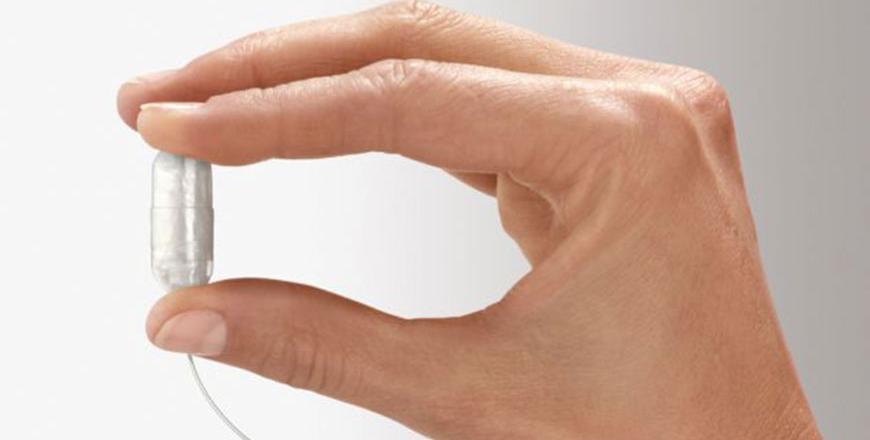You are here
A swallowed pill appears to deliver weight loss without gastric surgery
By Los Angeles Times (TNS) - Nov 21,2015 - Last updated at Nov 21,2015

A new gastric balloon procedure sees patients swallow a capsule (pictured) which contains a deflated balloon which is attached to a tube (Photo courtesy of Obalon)
A gastric balloon that’s swallowed like a pill and then sits in the stomach filled with fluid helped patients lose more than a third of their excess weight over a four-month period, researchers have reported.
The Elipse device has not been approved for weight loss by the Food & Drug Administration (FDA). But it is one of a new generation of “gastric balloons” aimed at helping the obese lose weight and improve related health conditions without undergoing an invasive and largely permanent replumbing of the digestive system.
In July, the FDA approved the “Reshape Dual Balloon” system, which is put in place during a 30-minute procedure during which a patient is mildly sedated.
The Elipse device, which is expected to come before the FDA for consideration soon, differs from the Reshape Dual Balloon in that it is swallowed rather than implanted into the stomach in an endoscopic procedure. Tethered to a tiny catheter, the Elipse device would be swallowed like a pill. Once in the stomach, the capsule dissolves, revealing a gastric balloon that is ready to be filled with sterile fluid through the catheter.
Once filled to roughly the size of a grapefruit, the balloon sits in the stomach for four months. By taking up room there, the balloon creates a sensation of fullness and helps a patient eat less and develop habits of portion control. After four months, the balloon is emptied and passed from the body in stool.
The device’s manufacturer, Allurion Technologies, calls the Elipse “the first procedure-less gastric balloon” and suggests it may be used to help those with a body mass index above 27 to lose weight.
A BMI of 25 is the cutoff point for overweight, and obesity is defined as a BMI above 30. The inclusion of non-obese patients in the population of the latest study suggests Allurion hopes to position the device as a treatment meant to prevent patients’ progression to obesity as well as to reverse it.
In research recently presented at the Obesity Society’s annual meeting, study co-author Dr Ram Chuttani reported that 34 overweight and obese subjects who got the balloon lost an average of 22 pounds after four months — roughly 37 per cent of their excess weight.
Chuttani, who is chief of interventional gastroenterology at Beth Israel Deaconess Medical Centre in Boston, said that patients who got the Elipse also saw improvements in their triglycerides and in haemoglobin A1C levels — a key measure of metabolic function.
The current study, sponsored by Allurion, had no comparison group of subjects who got a placebo treatment. Gastric balloons are widely reported to cause stomach discomfort and some vomiting, at least in the initial days and weeks after they are implanted.
Chuttani said that in addition to helping subjects feel full sooner, the Elipse appears to affect appetite, weight and physiological functions in some of the same ways that far more invasive bariatric procedures do: In addition to reducing the stomach’s capacity, it also appears to delay the process by which the stomach empties its contents and alters hormones that control hunger and appetite.
University of California, Irvine’s chief bariatric surgeon, Dr Ninh T. Nguyen, cautioned that the gastric balloon is not a permanent solution to weight loss. But Nguyen, who was not involved in the current study, said it may offer a treatment for overweight patients hoping to avert obesity, and to patients who may not be good candidates for bariatric surgery.
With nearly two-thirds of US adults overweight or obese and obesity now considered a disease, the Obesity Society’s meeting in Los Angeles this week underscores the clamorous effort to offer new treatments that are accessible to a wider range of patients.
Bariatric surgery’s Roux-en-Y bypass, which surgically removes a part of the stomach and reroutes food around part of the intestine, is still considered the most effective and enduring treatment of obesity and its related ills. But that procedure’s cost, invasiveness and irreversibility — as well as the technical demands of conducting the surgery — have left plenty of room for less radical and permanent treatments for obesity.
At this year’s meeting, researchers revealed that just three years after it was first introduced in the United States, a less radical bariatric procedure called sleeve gastrectomy — which uses sutures to create a smaller stomach “pouch” — has overtaken Roux-en-Y as the most-performed weight loss surgery.
Weight-loss medications, as well as devices such as gastric balloons and intestine-lining gastric “sleeves”, also appear to be diversifying choices for overweight and obese patients and their doctors.
Stanford bariatric surgeon Dr John Morton says that the growing portfolio of treatments will allow physicians to tailor their responses to meet the needs of patients in different stages of disease.
Morton, the current president of the American Society for Metabolic & Bariatric Surgery, likened the treatment of obesity to cardiology and cancer care just a decade or two ago: Earlier intervention — and the ability to offer patients combination treatments — not only should make treatment more effective, he said, it also should increase the field’s focus on preventing obesity-related disease.
Related Articles
PARIS — Weight-loss balloons swallowed rather than surgically inserted in the stomach were shown to be safe and effective in preliminary tri
Bariatric surgery has become the medical profession’s go-to solution for meaningful weight loss, and new research shows why: It saves lives.
When it comes to managing type 2 diabetes in overweight people, stomach-shrinking surgeries are still more effective than trying to shed pounds with pills and lifestyle changes, researchers said Monday.


















